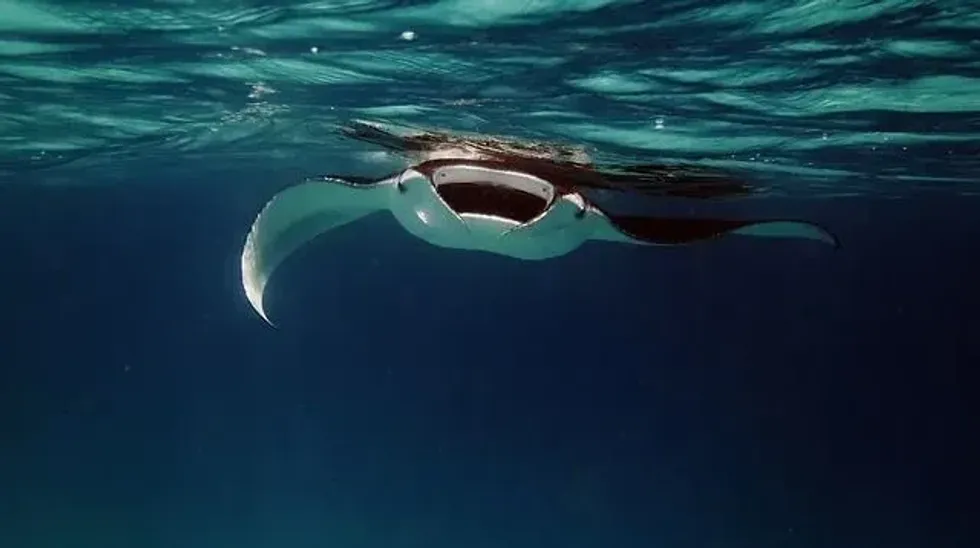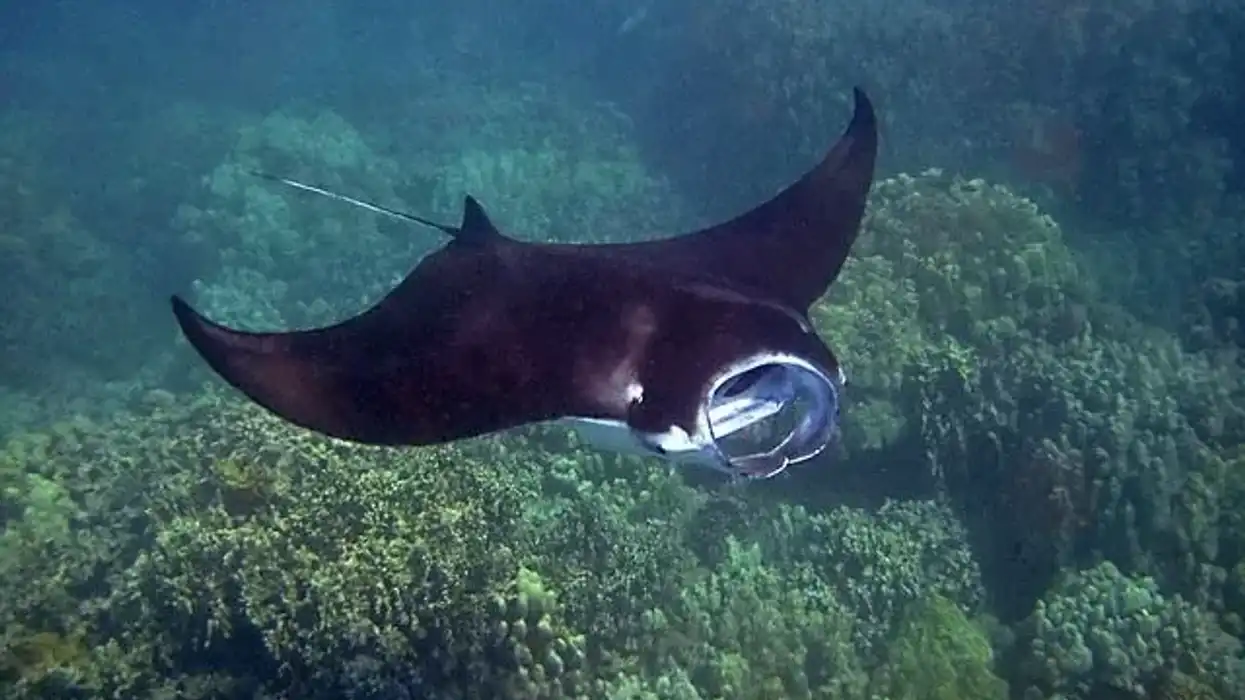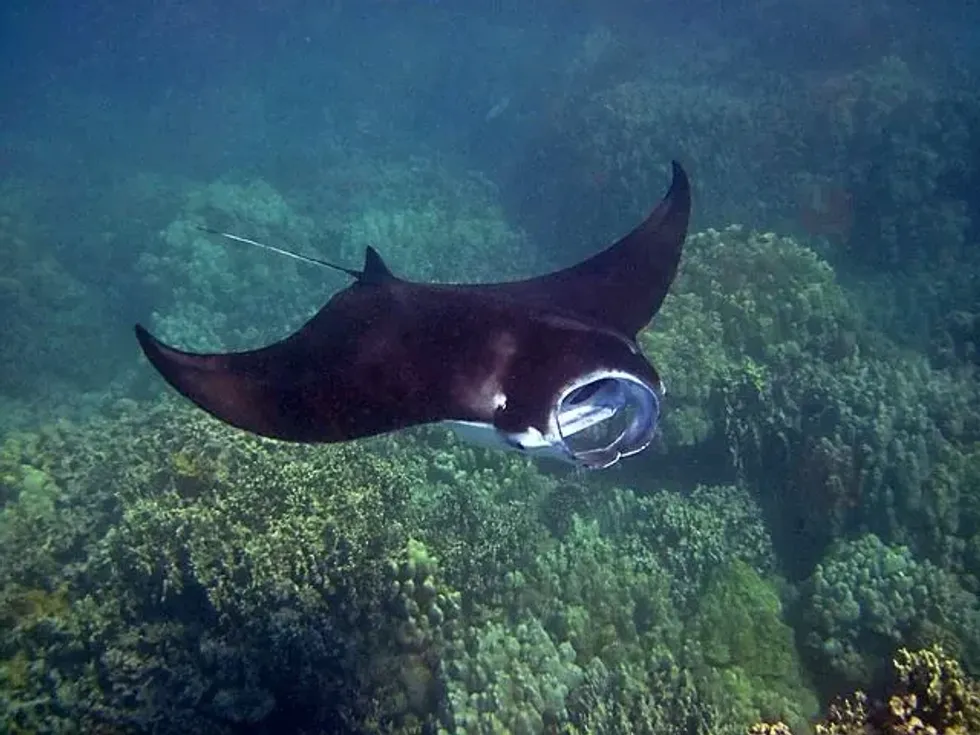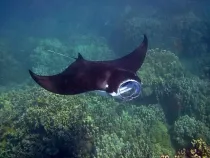Fun Manta Ray Facts For Kids

Content
- What type of animal is a manta ray?
- What class of animal does a manta ray belong to?
- How many manta rays are there in the world?
- Where does a manta Ray live?
- What is a manta ray's habitat?
- Who do manta rays live with?
- How long does a manta ray live?
- How do they reproduce?
- What is their conservation status?
- What do Manta Rays look like?
- How cute are they?
- How do they communicate?
- How big is a manta ray?
- How fast can a Manta Ray swim?
- How much does a Manta Ray weigh?
- What are their male and female names of the species?
- What would you call a baby Manta Ray?
- What do they eat?
- Are they dangerous?
- Would they make a good pet?
- Did You Know...
- Do people eat Manta Rays?
- Manta Ray vs Sting Ray
Huge, and terrifyingly beautiful can describe the legendary devil fish well. For centuries humans have feared them because of their deadly reputation.
But in truth, they are actually quite peaceful and do not pose any danger to humans at all. They are not known for attacking humans even remotely.
On the contrary, as they do not possess a barb on their tails like the Stingrays they evolved from, they are left completely vulnerable when they are attacked by humans. This is a major reason why heavy fishing in certain areas has almost pushed the species to the verge of extinction.
But as they are one of the largest fish in the whole world, other predators mostly leave them alone. They are known for jumping out of the water sometimes, although the reason remains mysterious, experts assume that it could be a way of getting rid of dead skin and parasites.
Interesting, right? Well, if you want to learn more fun facts about manta ray vs. stingray, then read on.
If you like to read more fun articles about animals, check out our similar ones on anchovies, and black marlin.
Manta Ray Interesting Facts
What type of animal is a manta ray?
Manta rays are a species of fish known to dwell in the oceans of the world. They are the largest rays in the world. Currently, two different species of the manta ray have been recognized by the experts, the giant oceanic manta rays and the reef manta ray.
What class of animal does a manta ray belong to?
Manta rays are a type of fish belonging to the class Chondrichthyes, which means that they have skeletons primarily made of cartilage, unlike the Osteichthyes types of fish, whose skeletons are primarily made of bone tissue.
How many manta rays are there in the world?
It is hard to say just how many manta rays are there in the world, but regionally their population is assumed to be as little as 100 individuals to as many as 1500 individuals.
The numbers of these fish have seriously declined in the heavy fishing areas. But thankfully, due to their Vulnerable (reef manta ray) and Endangered (giant manta ray, bentfin devilray) status on the IUCN Red List, many countries have banned fishing giant oceanic manta ray as well as reef Manta ray.
Hunting these fish in international waters is prohibited as well.
Where does a manta Ray live?
Giant Manta rays are one of the giants of the fish family, who are known to inhabit tropical waters of the world's oceans, such as, the Atlantic and Indo Pacific oceans. They are migratory and tend to travel across the open water.
What is a manta ray's habitat?
Unlike other types of rays, the manta ray (Mobula birostris) is found near the surface of the ocean at about 393.7 ft (120 m) depths of water. Reef Manta rays are often found living around coastal areas and reefs.
Who do manta rays live with?
Manta rays are solitary creatures and prefer to live alone. Especially the elusive giant oceanic Manta ray or the giant Manta ray, which are known to migrate across oceans. The Reef Manta ray is more common as it is assumed to be residents around reefs and coastal areas.
How long does a manta ray live?
Manta rays usually live for about 20 years, but some of the giant Manta ray, although less in number, have been known to live as long as 50 years.
How do they reproduce?
The mating season of giant manta rays or Manta birostris occurs between December to January. They are known for mating in tropical and subtropical waters.
A large number of Giant Manta rays are known to gather in these places during this time. Sometimes several males are known to court a single female.
The average gestation period of a giant Manta ray is about 12-13 months, after which one to two live pups are born. The pups can move freely on their own since they are born, and then they are left to fend for themselves.
What is their conservation status?
The gill rakes of manta rays are a popular component in some traditional Chinese medicine, due to this, heavy fishing for their gill rakes has pushed both the giant manta ray and reef manta ray population to almost being threatened.
They are listed as Vulnerable (reef manta ray) and Endangered (giant manta ray, bentfin devilray) on the IUCN Red List. These fish tend to live a long life and are slow to produce young, so their numbers have taken a great hit around the world due to heavy fishing.
Thankfully, many countries including the United States and New Zealand have banned the fishing of these animals in their national waters to prevent these species from going extinct.
Manta Ray Fun Facts
What do Manta Rays look like?
Manta rays have large bodies that are completely flat and diamond-shaped in their appearance. They have triangular pectoral fins that seem wing-like in their appearance.
The wingspan of this migratory species can grow up to 29 ft (8.53 m) wide. They are mostly black in color with distinguished spots on their bellies.
Some, though have been known to have black-colored blacks and a pale underside. Their eyes are located sideways on their broad head, and a terminal mouth lined with small rakes helps them sift through plankton and krill.
Two cephalic lobes are extending out from the front of the heads of giant manta rays, this, strangely has earned them the title of Devilfish.
Sailors in the old days have created a lot of myths regarding the giant manta ray, giving them a reputation for being evil. Although these tales are indeed interesting, they are nothing but tall tales.

How cute are they?
Even though they are extremely large, they can appear quite cute to some people with their black bodies with unique spotted patterns. To others though, they might appear to be terrifying in their huge length and the two menacing-looking front cephalic lobes.
This is precisely what has earned the giant Manta ray the title of being the devilfish. Completely contradicting their reputation, they are actually quite peaceful and curious in nature.
And these massively beautiful water animals pose no threat to humans at all. In fact, in some places, if you are cautious enough, you can even swim with Manta ray.
How do they communicate?
It is hard to answer how do manta rays communicate, but by observing their behavior, experts assume that along with their body language, the giant manta ray uses its cephalic lobes to communicate with each other. They observed that these lobes move in certain ways when the manta rays are interacting with their own kind.
They might also use it to garner attention from the wrasse fish whom they use as 'cleaning stations'. Confused?
Well, what basically happens is that in these portions the wrasse fish swim about them in groups, picking off parasites and dead skin from the bodies of the manta rays. This is why the experts called them 'cleaning stations'.
How big is a manta ray?
Manta rays are large animals and are considered to be one of the largest fish in the world. They have broad, flat bodies that are wider than they are longer.
They have pectoral fins that can seem wing-like in their appearance. These wings can be as wide as 18-22 ft (5.48-6.70 m) for female manta rays, and 17-20 ft (5.18-6.09 m) wide for male manta rays.
The largest manta ray recorded had a wingspan of about 30 ft (9.14 m).
Interestingly, that is the same distance a Kangaroo can cross in a single leap. Reef manta rays with a wingspan of about 11 ft (3.35 m) are a little smaller in size and more common to the human eyes, as they are thought to be residents around reefs and coastal areas.
Giant manta rays on the other hand are more solitary in nature and prefer to migrate across open waters. Read on to learn more fun facts about manta ray size.
How fast can a Manta Ray swim?
Even though mantas are a peaceful species, when it comes to running from predators, they can be very, very fast. Both giant manta rays, as well as reef manta rays, have a recorded swimming speed of 14.9 mph (23.9 kph) when running from a potential threat.
How much does a Manta Ray weigh?
Manta rays are large-bodied fish. They are one of the giants of the fish family, not to mention that both giant oceanic manta ray and reef manta ray species are the largest rays in the world.
The Giant oceanic manta ray or the giant manta rays generally weigh up to 2643.2-3083.7 lb (1198.93-1398.74 kg), but some giant manta rays have been known to weigh as much as 5300 lb (2904 kg)!
What are their male and female names of the species?
Manta rays do not have gender-specific names for their male and female counterparts. The male giant manta ray is called a male giant manta ray and a female giant manta ray is called a female giant Manta ray.
There is some sexual dimorphism in these fish though, while the wingspan of the female Mantas can grow up to 18-22 ft (5.48-6.70 m) wide, the wingspan of male mantas are usually 17-20 ft (5.18-6.09 m) wide.
What would you call a baby Manta Ray?
As with most large fish, young manta rays are generally called pups. The young of these fish are like miniature versions of their parents when they are born, and, interestingly, they have been known to be able to move on their own from the get-go.
The pups can weigh up to 24.2 lb (10.27 kg) at birth. The growth of manta rays is known to be rapid, the young can increase their body size up to double the length of their initial size within a year of being born.
What do they eat?
These mild-mannered animals are filter feeders, they have small rakes lining their mouths that help them filter through zooplankton, krill, and shrimps to their large terminal mouths. There are also known to eat large amounts of different types of small to medium-sized fish.
The two cephalic lobes on the front of the head of giant oceanic manta ray also help them to direct these fish, shrimps, and krill to their mouth.
In turn, manta rays are also hunted by predators of the open water bodies, such as large sharks and even orcas. Humans can also be called predators of these animals.
The gills of both species of manta rays are considered to be valuable as they are popular components of some traditional Chinese medicine.
But, thankfully in recent years, many countries have restricted the fishing of both species of manta rays, to prevent them from going extinct. This includes preventing people from hunting mantas in international waters as well.
Are they dangerous?
Although large in size, these cold-blooded fish actually pose no danger to humans. They are calm and peaceful, and some even appear curious if approached by humans in a non-threatening manner.
The cephalic lobes situated at the front of their heads might make their appearance seem evil to some people, which is why another popular name of the giant manta rays is the devilfish. But they are non-aggressive and are not known for posing any kind of threats to humans at all.
Would they make a good pet?
As Mobula birostris or giant oceanic manta ray and Manta alfredi or reef manta ray are both extremely large animals and live in even larger water bodies, such as oceans, it is simply not possible to create that atmosphere at home. As a result, they cannot survive in captivity.
So large fish of any kind, whether they are Manta rays or any other rays in the world, do not make good pets at all.
Did You Know...
Manta ray is one of the largest fish in the whole world.
They have a massive brain, in fact, the biggest brain-to-body ratio of any fish. And they are so intelligent that they can easily challenge even primates.
Do people eat Manta Rays?
They are not very flavorful as it may seem, but some good places/restaurants do exist where they serve some really lip-smacking manta ray meat dishes in their menu. The top lists include a Mexican dish (ideally a sea food) named Caguamanta and other BBQ versions of it are something to try for if you're a sincere food explorer.
Whereas in China, the same manta rays' gill rakes are used as a popular therapeutic component.
Manta Ray vs Sting Ray
Manta rays actually evolved from Stingrays, so as a result, they seem quite similar in their appearance. They both have broad, flat bodies with wing-like pectoral fins attached.
But at a closer look, you will find that Manta rays do not possess the barbs on their tails that earn the Stingrays their name. As a result, while the barbs on the Stingray's tail do sting, Manta rays do not. Stingrays are also known as bottom dwellers while Manta rays are known for migrating across open oceans.
Here at Kidadl, we have carefully created lots of interesting family-friendly animal facts for everyone to discover! Learn more about some other fish including codfish, or spiny dogfish.
You can even occupy yourself at home by drawing one of our Stingray coloring pages.
We Want Your Photos!
More for You
Sources
https://en.wikipedia.org/wiki/Manta_ray
https://www.britannica.com/animal/manta-ray
https://a-z-animals.com/animals/manta-ray/
See All
Bachelor of Arts specializing in Journalism and Mass Communication, Postgraduate Diploma in Sports Management

Moumita DuttaBachelor of Arts specializing in Journalism and Mass Communication, Postgraduate Diploma in Sports Management
A content writer and editor with a passion for sports, Moumita has honed her skills in producing compelling match reports and stories about sporting heroes. She holds a degree in Journalism and Mass Communication from the Indian Institute of Social Welfare and Business Management, Calcutta University, alongside a postgraduate diploma in Sports Management.
Bachelor of Technology specializing in Information Technology

Smriti ChaudharyBachelor of Technology specializing in Information Technology
Smriti, a student data scientist, and coder, is pursuing her Bachelor of Technology at K.J. Somaiya College of Engineering. She has achieved top rankings in the International English Olympiad, National Spelling Bee, and PSAT/SAT English Section. She is experienced in content creation and editing for various academic institutions.
Disclaimer
1) Kidadl is independent and to make our service free to you the reader we are supported by advertising. We hope you love our recommendations for products and services! What we suggest is selected independently by the Kidadl team. If you purchase using the Buy Now button we may earn a small commission. This does not influence our choices. Prices are correct and items are available at the time the article was published but we cannot guarantee that on the time of reading. Please note that Kidadl is a participant in the Amazon Services LLC Associates Program, an affiliate advertising program designed to provide a means for sites to earn advertising fees by advertising and linking to Amazon. We also link to other websites, but are not responsible for their content.
2) At Kidadl, we strive to recommend the very best activities and events. We will always aim to give you accurate information at the date of publication - however, information does change, so it’s important you do your own research, double-check and make the decision that is right for your family. We recognise that not all activities and ideas are appropriate for all children and families or in all circumstances. Our recommended activities are based on age but these are a guide. We recommend that these ideas are used as inspiration, that ideas are undertaken with appropriate adult supervision, and that each adult uses their own discretion and knowledge of their children to consider the safety and suitability. Kidadl cannot accept liability for the execution of these ideas, and parental supervision is advised at all times, as safety is paramount. Anyone using the information provided by Kidadl does so at their own risk and we can not accept liability if things go wrong.
3) Because we are an educational resource, we have quotes and facts about a range of historical and modern figures. We do not endorse the actions of or rhetoric of all the people included in these collections, but we think they are important for growing minds to learn about under the guidance of parents or guardians.







